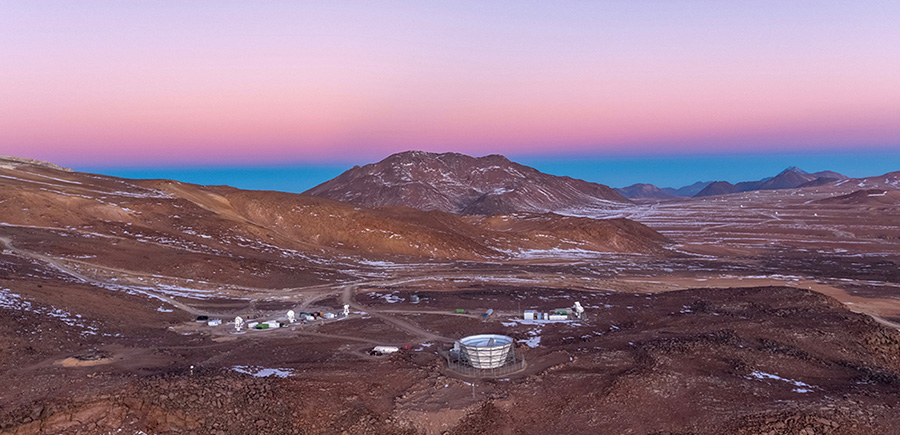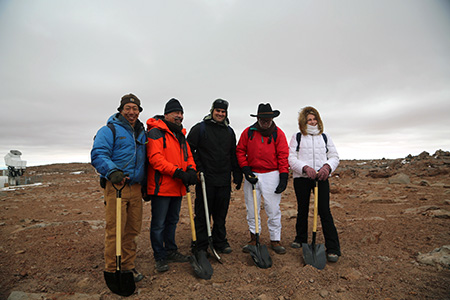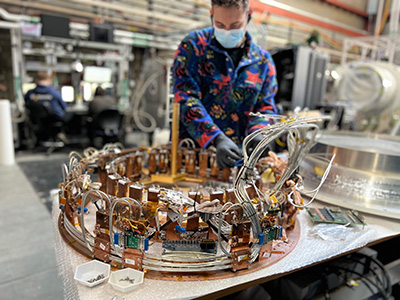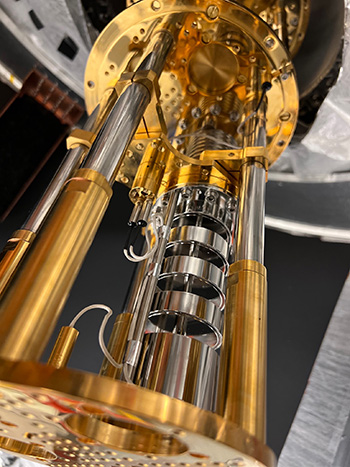UC San Diego Cosmologists Work on Radio Telescope Bound for Simons Observatory in Chile
January 13, 2023 | By Stuart Volkow
It’s been a busy year for the Simons Observatory, one of UC San Diego’s largest research projects. The observatory is one of the most ambitious cosmic microwave background experiments ever undertaken to study the origin and evolution of the universe. After more than six years of planning, building and testing, the four-telescope array is nearing completion.

The observatory site is in the northern region of the Andes Mountains in Chile. Rising to over 6,700 meters (22,000 feet) above sea level, these mountains contain one of the driest deserts on Earth, making it one of the best places for radio astronomy. Many of the world’s most advanced radio telescopes share this high Atacama plane in an area designated by the Chilean government as Parque Astronómico Atacama, protected from light pollution and unwanted radio interference.
Located on the volcanic mount of Cerro Toco at 5,200 meters (17,200 feet), the Simons Observatory is one of the highest in the world. With only half the atmospheric pressure of sea level, workers are required to wear supplemental oxygen while onsite, not to mention plenty of UV sun protection!
Established in 2016 by UC San Diego Professors Brian Keating and Kam Arnold, along with collaborators from Princeton University, the University of Pennsylvania, UC Berkeley, the Simons Observatory project has grown to over 380 scientists, engineers and staff from academic institutions around the world. This work is supported by generous grants from the Simons Foundation, the Heising-Simons Foundation and contributing academic institutions.

Searching for the Origins of the Universe
The uniquely designed Simons Observatory (SO) telescopes are unlike the optical telescopes one might use for backyard stargazing. The quarry that SO’s telescopes capture are far from visible light, far from the infrared wavelengths of the new James Webb Space Telescope, and at higher frequencies than those used by radar and satellite communications. The energy being sought is the faint, fossil remnant of the Big Bang itself, called the cosmic microwave background (CMB).
The CMB is an energy that permeates the observable universe. Of particular importance, SO cameras are designed to detect and study polarization characteristics of the CMB called B-modes — properties that could reveal evidence for primordial gravitational waves, shockwaves from the instant the universe was created known as cosmic inflation.
Keating noted that “the observation of B-mode polarization in the CMB would rule out or constrain other models of cosmogenesis and provide strong evidence for inflation and the single Big Bang.”
The observatory will reveal details about galaxy clusters and their formation, neutrino mass, dark energy, dark matter, and the character of what cosmologists call primordial perturbations — the quantum events from which the universe evolved. The telescope array will also have the capability of detecting another ubiquitous cosmic phenomenon, interstellar dust.
“The universe is full of asteroids, meteorites and other sources of interstellar dust that can mimic the big bang signal we seek. The Simons Observatory is designed to detect, account for and subtract interstellar dust from the signal we want, so that our data is precise and reliable,” said Keating.

the cryogenic focal plane module for the SATR. (cr: Stuart Volkow/UC San Diego)
Each SATR features seven hexagonal detector wafers with 12,000 exquisitely sensitive superconducting detectors, designed by a team led by Princeton University Professor Suzanne Staggs and fabricated in the Quantum Sensors Group at the National Institute of Standards and Technology in Boulder, Colorado. These detectors combine an antenna with devices called transition-edge sensor bolometers, which can detect slight variations in the CMB, including polarization. Taken together, the four receivers in the array will have 60,000 detectors, more than all previous CMB experiments combined.
To maintain sensitivity and reject noise, the superconducting detectors operate at extremely low temperatures — 100 millikelvin. Sustaining this ultra-low temperature is a feat of cryogenic engineering, requiring a combination of techniques including pulse tube cryocoolers (PTC). The distinctive rhythmic thumping in the UC San Diego High Bay Lab is the sound of the PTC helium compressors, which ultimately lower receiver chamber temperatures down to about 4 kelvin. Getting to the ultra-low 100 millikelvin temperature requires the integration of another type of cooler called a dilution refrigerator. These are the same devices used in quantum computing research and other extreme cryogenic experiments.

The SATR is a wonder of thermo-mechanics that keeps the right temperatures in the right places in a near-total vacuum. For the past three years, the UC San Diego team, led by former postdoctoral scholar (now professor at University of Texas) Nick Galitzki and Professor of Physics Kam Arnold, has put the SATR through over a dozen cooldowns. Kitted out with precise thermometry to monitor the temperature in all chambers of the receiver, the UC San Diego team tests, measures, adjusts and retests the systems under various stresses with different components.
The SATRs feature 50-cm filters and rotating, cryogenic, half-wave plates that “levitate” in a magnetic field created by a ring of superconducting tiles, and a ring of neodymium magnets cooled to 40 kelvin. This allows the circular waveplate to spin at a constant rate without friction or vibration for years, modulating the CMB signals. Unlike Ray Bans, however, these polarization optics are made of sapphire and are the largest of its kind ever made. They allow cosmologists to detect slight variations in the patterns of CMB energy that may reveal details leftover from the origin of the universe that we see today.
The team of students, postdoctoral scholars and faculty in the High Bay Lab must also validate multiple stages of electronics and software essential to pulling all the elements of the telescopes together, and reliably streaming out the terabytes of data that will be collected over the years.
As the SAT1 receiver undergoes its final trials, UC San Diego students, postdoctoral scholars, faculty, and observatory staff are readying the site and paving the way for the complex logistics to place the instrument onto its platform, ready to scan the southern sky, and begin sending data to cosmology collaborators around the world, anticipating discoveries that will change our understanding of the universe.
Under the direction of Arnold and Keating, UC San Diego is home to the Simons Observatory Project Office, which leads, coordinates, and manages the observatory endeavor. Staff include Deputy Director Leah Valmidiano, Project Scientist Grant Teply, Systems Engineer Delwin Johnson, R&D Engineer Chris Munson, and research assistant JB Lloyd. Graduate students include Maximiliano Silva-Feaver, Joseph Seibert, Tran Tsan, Bryce Bixler and Michael Randall. They work on the endless logistical and engineering details to keep the project on schedule and budget.
For More Information
